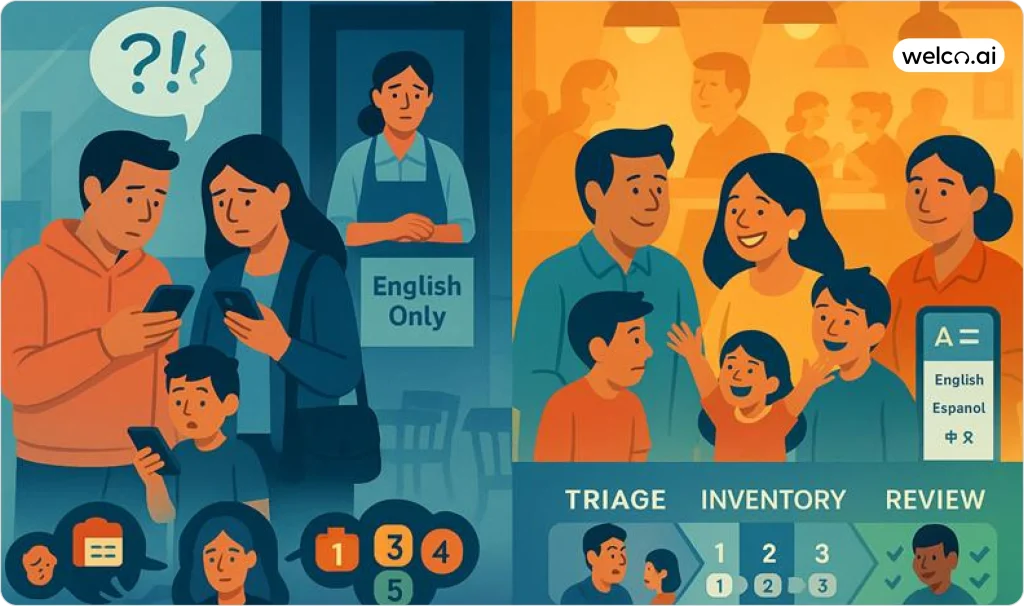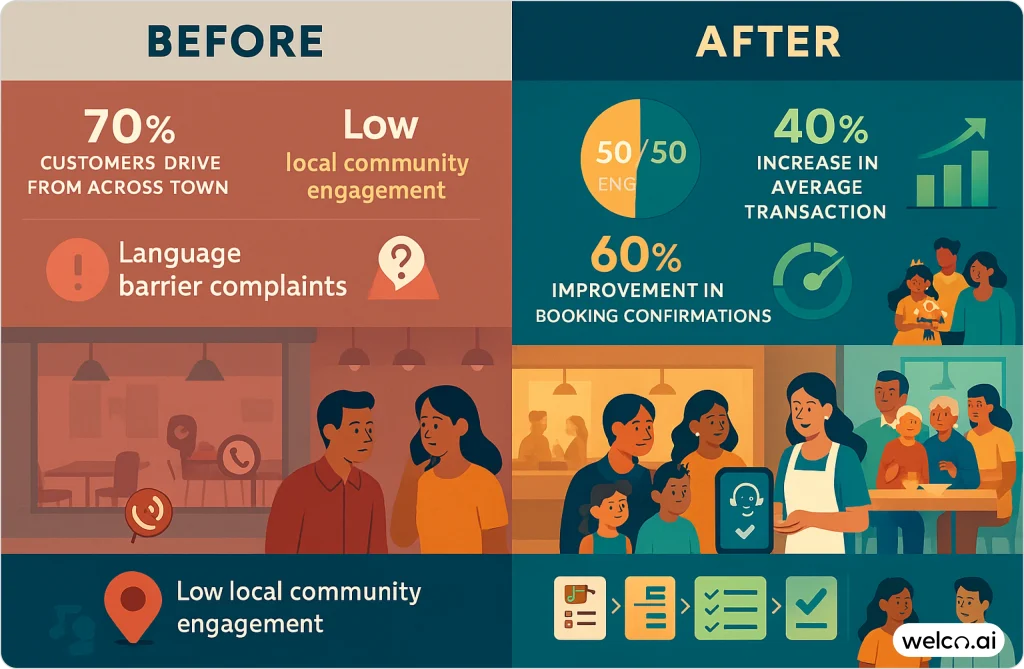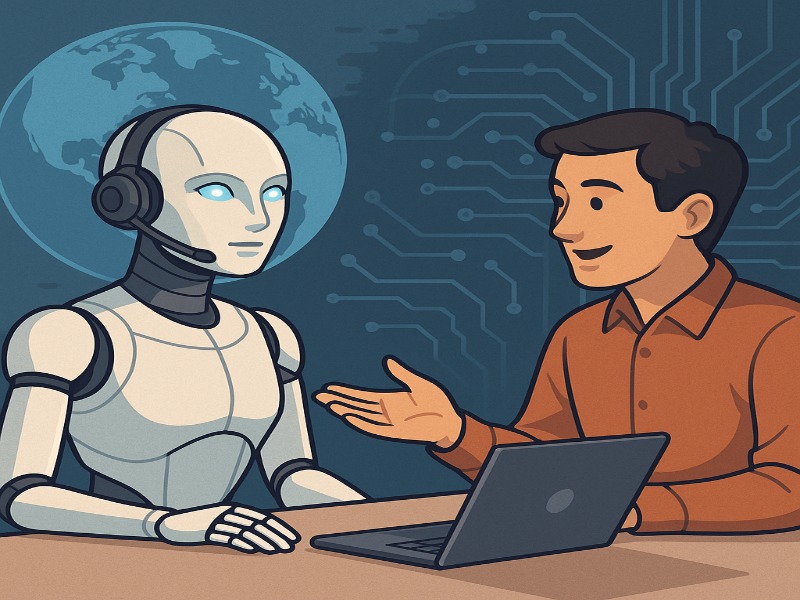Maria owned a family restaurant in the heart of a Hispanic neighborhood in Phoenix. Every day, she watched Spanish-speaking families walk past her window to eat at chain restaurants 20 minutes away. Meanwhile, 70% of her customers drove from across town—English speakers who’d discovered her authentic Mexican food online.
“I don’t understand,” she told me. “My food is better, my prices are lower, and I’m right here in their neighborhood. Why won’t they come?”
The answer hit me when I called her restaurant myself.
The phone greeting was warm but entirely in English. The voicemail? English-only. When I left a message in Spanish asking about catering for a family celebration, no one called back.
Local families had written Maria’s restaurant off as “not for us.”
Six months later, everything changed. Maria implemented an AI receptionist trained in cultural communication patterns. Now she serves a 50/50 mix of English and Spanish-speaking customers. More importantly, her Spanish-speaking customers became her most loyal advocates, bringing friends and family weekly.
The transformation wasn’t about hiring more bilingual staff or expensive human translators. It was about understanding that language is just the entry point to cultural connection—and AI can excel at both.

The Translation Trap That Kills Customer Relationships
Here’s what most businesses get wrong about serving diverse customers:
They Focus on Words, Not Communication
A Spanish-speaking customer calls about hosting a quinceañera. Your human staff member translates perfectly but rushes through the call like it’s a quick lunch order, because they’re juggling three other tasks.
To you, this feels efficient. To the customer, it feels dismissive.
In many Latino cultures, family celebrations aren’t transactions—they’re relationship-building moments. That customer needed time to discuss details, ask about accommodating extended family, and feel confident you understood the importance of their event.
An AI receptionist doesn’t rush through calls. It’s designed to recognize cultural cues and adapt conversation pace accordingly.
They Think All Spanish Speakers Are the Same
I’ve watched businesses proudly advertise “¡Hablamos Español!” while treating a Mexican family the same as customers from Puerto Rico or Spain.
A Mexican customer might expect warm, relationship-focused service with time for family consultation. A Spanish customer might prefer more formal, efficient interactions. Both speak Spanish. Both have completely different service expectations.
Human staff often forget these nuances between interactions. AI maintains detailed preference records for each customer.
They Let Human Limitations Impact Service Quality
Human receptionists have bad days, get overwhelmed, or forget which customers prefer relationship-building versus efficiency. They can’t instantly access preference data from previous interactions across busy shifts.
AI receptionists maintain consistent service quality. They remember that Mrs. Rodriguez prefers formal greetings and that the Chen family likes detailed explanations before making decisions.
The businesses that succeed understand: effective multilingual service requires round-the-clock responsiveness—and AI excels at delivering consistent quality.
Understanding how first impressions are formed in those critical opening moments becomes essential when serving diverse customers who may have different expectations about professional communication.
The Four Things AI Does Exceptionally Well
Understanding these challenges, let’s explore how AI receptionists address each of these pain points. After helping dozens of businesses like Maria’s implement AI receptionists, I’ve seen the same advantages repeatedly. AI doesn’t follow complex frameworks—it learns and adapts to interaction styles automatically.
AI Consistently Remembers Customer Communication Styles
Take David, who runs a financial planning firm. His human receptionist kept scheduling quick 30-minute calls with Hmong clients, not understanding they needed relationship-building time.
The problem? Human staff couldn’t track individual preferences across hundreds of customers, especially during busy periods.
Once David implemented an AI receptionist, the system automatically flagged relationship-focused clients and scheduled longer initial consultations. It remembered that many Hmong clients preferred to discuss family backgrounds before business details.
David’s retention rate jumped from 30% to 85% because AI consistently applied learned customer preferences.
The key: AI doesn’t just recognize interaction styles—it stores and applies them to every future conversation.

AI Accommodates Family Decision-Making Naturally
Remember when you bought your last car? You probably decided quickly. But imagine if you had to get approval from your parents, consult your siblings, and consider what your extended family would think.
That’s reality for many of your customers, and human staff often show impatience with “delayed” decisions.
Maria’s AI receptionist learned this when a grandmother called about catering for her granddaughter’s quinceañera. Instead of pushing for immediate decisions, the AI responded, “That sounds wonderful. I’d be happy to prepare some options for you to review with your family, and we can schedule a follow-up call whenever works best.”
The grandmother came back two weeks later with her daughter and granddaughter. They booked a $3,000 event and have since referred four other families.
The difference: AI treats family consultation as excellent service, not delayed decision-making, because it’s designed to accommodate different decision-making styles.
AI Adapts to Formality in Real-Time
Here’s where human receptionists often struggle: they develop habits and treat everyone the same way throughout long shifts.
I watched this happen at a law office serving both tech workers and recent immigrants. The human receptionist greeted everyone with “Hey there! How’s it going?”
The tech workers loved it. The immigrant clients? They felt disrespected.
AI receptionists analyze speech patterns and language choices in real-time. When someone introduces themselves as “Dr. Martinez,” the AI responds with “Good morning, Dr. Martinez.” When someone says “Hey, I’m Mike,” it matches that casual tone.
AI Maintains Patience During Complex Conversations
This is where businesses lose the most customers—and where AI provides significant value.
Sarah runs a medical practice where some patients want quick, efficient appointments while others need time to explain their symptoms, ask about their family’s health history, and understand every treatment option.
Human receptionists naturally get frustrated with lengthy calls during busy periods. AI receptionists maintain the same helpful approach regardless of call duration. They recognize when someone needs detailed discussion versus quick scheduling.
The advantage: AI provides consistent responsiveness even during peak hours when human staff feel pressed for time.
For highly sensitive medical discussions or complex family situations, AI can seamlessly transfer to trained human staff while providing complete context from the conversation. Organizations dealing with particularly challenging scenarios can benefit from learning how to manage complex customer interactions effectively.
How Maria Transformed Her Restaurant with AI
Here’s exactly what happened when Maria implemented an AI receptionist:
Week 1: The AI system began answering calls in both English and Spanish, automatically detecting language preference and adjusting its communication style accordingly.
Week 2: The AI started recognizing when callers mentioned family celebrations and automatically provided extended consultation time, asking about guest counts, dietary restrictions, and cultural preferences.
Week 3: The system began tracking which customers preferred relationship-building versus efficiency, creating detailed profiles that improved with every interaction.
Week 4: AI-generated follow-up calls and texts in customers’ preferred languages resulted in a 60% increase in booking confirmations from Spanish-speaking customers.
The result? Spanish-speaking customers started staying longer, bringing larger groups, and referring friends. Her average transaction size increased 40% because families felt comfortable discussing their real needs, and the AI consistently remembered their preferences.
Why AI Receptionists Excel at Multilingual Service
Consistent Memory Management
AI typically remembers that the Gonzalez family prefers relationship-building conversations or that Mr. Wang likes formal, efficient interactions. Human staff often forget these details when managing hundreds of customers.
Round-the-Clock Availability
Your AI receptionist provides the same high-quality service adaptation at 2 AM as it does at 2 PM. Human staff naturally have energy fluctuations throughout long shifts.
Broad Language Capabilities
While human receptionists usually speak 1-2 languages fluently, AI can handle multiple languages while maintaining appropriate communication styles for each.
Rapid Learning Updates
When communication best practices evolve, AI systems can incorporate improvements quickly across all customer touchpoints. Training human staff on new approaches takes considerably longer.
For businesses looking to optimize these capabilities further, implementing comprehensive 24/7 customer service optimization strategies can transform basic multilingual support into a complete competitive advantage.
Start Small, See Immediate Results

You don’t need to overhaul everything at once. Here’s what happens when you implement AI receptionist services:
Day 1: AI begins answering calls in multiple languages with appropriate communication styles for each caller.
Week 1: The system starts building preference profiles for regular customers, improving service quality with each interaction.
Week 2: You’ll notice longer conversations with diverse customers and improved booking rates from non-English speaking callers.
Month 1: Customers become advocates as they experience consistent, respectful service that remembers their preferences and communication styles.
Most businesses see significant improvements in diverse customer engagement within the first month of AI implementation.
The Real Competitive Advantage of AI Receptionists
Businesses that leverage AI-powered communication don’t just serve diverse customers—they create advocates through unprecedented consistency.
When customers feel genuinely understood and respected by AI that remembers their preferences, they become loyal supporters. They bring family members, refer friends, and choose you over competitors even when it’s less convenient.
Maria’s restaurant now has a waiting list for weekend family celebrations. Her Spanish-speaking customers don’t just eat there—they’ve made it their community gathering place, largely because an AI receptionist made them feel genuinely welcome from the first call.
That’s the difference between translation and transformation—and AI delivers it reliably.
The foundation for this success lies in understanding that every customer interaction follows predictable patterns. Businesses ready to take their multilingual service to the next level often benefit from implementing a strategic journey mapping framework that ensures consistent experiences across all languages and cultures.
Ready to turn your language barriers into competitive advantages? AI receptionists can start serving your diverse customers today with systems that remember preferences, maintain patience, and provide consistent service around the clock.
The businesses that implement AI receptionists thoughtfully will gain significant advantages in their diverse markets. Those that rely solely on inconsistent human-only approaches may find themselves losing customers to competitors who make everyone feel truly welcome 24/7.
Beyond basic implementation, developing a consistent voice brand identity ensures that your multilingual service feels authentic and professional across all languages, while understanding call routing psychology helps prevent cultural misunderstandings that can derail even well-intentioned interactions.
Frequently Asked Questions
My business is small and we only get a few multilingual customers per week. Is AI receptionist technology worth it for us?
Even small volumes can justify AI receptionists when you consider the lifetime value of diverse customers. Remember Maria’s grandmother who booked a $3,000 event and referred four families? One well-served customer from a cultural community often becomes a gateway to that entire network. AI receptionists also handle your existing English-speaking customers better by maintaining consistent service quality during busy periods.
What if our AI receptionist misunderstands cultural cues and offends someone? How do we prevent cultural mistakes?
AI receptionists are trained on thousands of cultural interaction patterns and err on the side of respectful formality when uncertain. They’re also programmed to ask clarifying questions like “What timing works best for you?” rather than making assumptions. Most importantly, they can instantly transfer to human staff when conversations become complex, while providing complete context about the customer’s preferences and communication style.
Our current phone system is old and basic. Would we need to completely overhaul our technology to implement an AI receptionist?
Most AI receptionist services integrate with existing phone systems through simple forwarding or VoIP connections. You don’t need new hardware or complex installations. Many businesses start by having the AI handle overflow calls or after-hours inquiries, then gradually expand as they see results. The implementation is typically much simpler than hiring and training additional multilingual staff.
How do we measure if the AI receptionist is actually improving our relationships with diverse customers versus just handling more calls?
Track relationship indicators beyond call volume: repeat customers bringing family members, referrals within cultural communities, longer average call durations (indicating comfort), and booking conversion rates from initial contact. Many businesses also see increases in average transaction size as customers feel comfortable discussing their full needs rather than rushing through calls.
What if customers from different cultures have conflicting expectations during the same interaction? For example, one family member wants quick service while another wants to chat.
This happens more often than you’d think, especially with families spanning different generations. The solution is to acknowledge both needs: “I can see some of you are ready to move forward while others might have more questions. How would you like to handle this?” Let the family guide you on their preferred approach. Often, the person who wants to chat will take the lead, and others will appreciate that their family member feels heard. For businesses serving diverse communities, personalization in automated customer interactions can help AI systems recognize and adapt to these nuanced family dynamics automatically.
